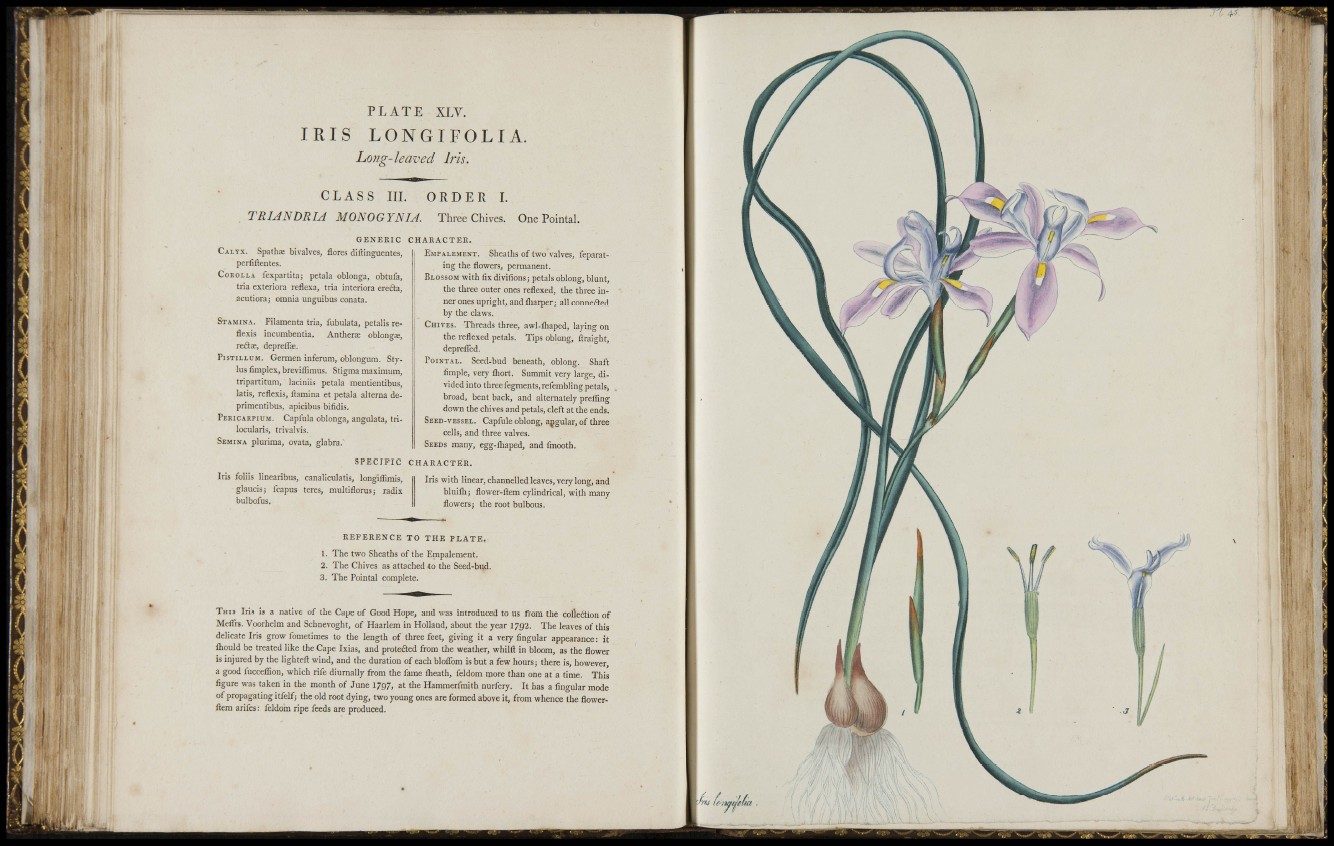
. J
Ì
!
!
O
so P
P L A T E XLV.
I R I S LONGIFOLIA.
hong-leaved Iris.
C L A S S III. ORDER L
TRIANDRIA MONOGYNIA. Three Chives. One Pointal.
G E N E r a c
CALYX. Spathoe bivalves, flores diñinguentes,
perfiñentes.
COROLLA fexpartita; pétala oblonga, obtufa,
tria exteriora reflexa, tria interiora erefta,
acutiora; omnia unguibus conata.
STAMINA. Filamenta tria, lubulata, petalis reflexis
incumbentia. Antlieras oblongee,
retlae, deprelTae.
PisTiLLüM. Germen inferura, oblongum. Stylus
fimplex, brevifliraus. Stigma maximum,
tripartitum, laciniis pétala mentientibus,
latis, reflexis, ñamina et pétala alterna deprimentibus,
apicibus bifidis.
PEKICARPIUM. Capfula oblonga, angulata, trilocularis,
trivalvis.
SEMINA plurima, ovata, glabra.
C H A R A C T E E .
EMPALEMENT. Sheatlis of two valves, feparating
the flowers, permanent.
BLOSSOM with fix divifions; petals oblong, blunt,
the three outer ones reflexed, the three inner
ones upright, and fliarper; all conneded
by the claws.
CHIVES. Threads three, awl-ihaped, laying on
the reflexed petals. Tips oblong, ftraight,
deprefled.
TOINTAL. Seed-bud beneath, oblong. Shaft
fimple, very fliort. Summit very large, divided
into three fegments,refembling petals,
broad, bent back, and alternately prefling
down the chives and petals, cleft at the ends.
SEED-VESSEL. Capfule oblong, açgular, of three
cells, and three valves.
SEEDS many, egg-fliaped, and fmooth.
S P E C I F I C CHARACTEE.
Iris foliis linearibus, canaliculatis, longiffimis,
glaucis; fcapus teres, multiflorus; radix
bulbofus.
Iris with linear, channelled leaves, veiy long, and
bluifli; flower-fl:em cylindrical, with many
flowers; the root bulbous.
R E F E R E N C E TO THE PLATE.
1. The two Sheaths of the Empalement.
2. The Chives as attached to the Seed-bud.
3. The Pointal complete.
THIS Iris is a native of the Cape of Good Hope, and was introduced to us from the colleaion of
Meflrs. Voorhelm and Schnevoght, of Haarlem in Holland, about the year 1792. The leaves of this
delicate Iris grow fometimes to the length of three feet, giving it a veiy Angular appearance: it
Ihould be treated like the Cape Ixias, and proteded from the weather, whiltl in bloom, as the flower
is injured by the lighteft wind, and the duration of each bloflTom is but a few hours; there is, however,
a good fucceflion, which rife diurnally from the fame flieath, feldom more than one at a time. This
figure was taken in the month of June 1797, at tlie Hammerfmith nurfery. It has a fingular mode
o f propagating itfelf; the old root dying, two young ones are formed above it, from whence the flowerftem
arifes: feldom ripe feeds are produced.